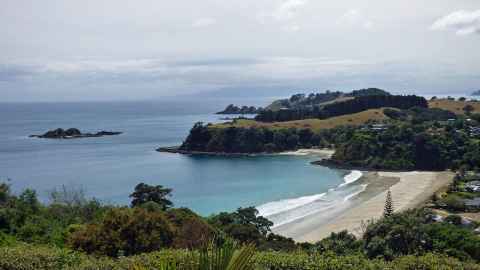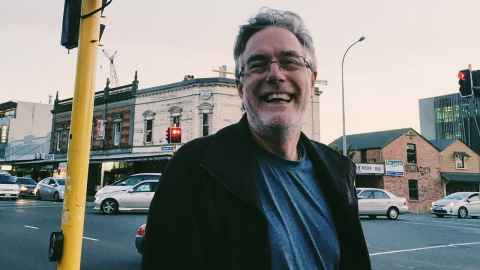Lockdown gave us an experience of Mason Durie’s Te Pae Māhutonga
3 June 2020
Opinion: Professor Robin Kearns from the University of Auckland's School of Environment reminisces about our enforced slowdown through lockdown.

Places, like people, never stay the same. Places are always in a state of becoming. How did the places familiar to us change over the time we came to know as ‘lockdown’?
On Waiheke Island where I live, ‘quieter,’ ‘friendlier’ and ‘cleaner’ were three common responses. With all but essential vehicles off the roads, pedestrians turned back the clock. We walked the way people did before the hegemony of cars. When a vehicle did pass, we waved. But we noticed the odour of exhaust emissions more acutely than when immersed in the miasma of Auckland’s rush-hour.
It was a time of noticing the non-human life with which we share the planet. We heard more birdsong. With roads quiet and the engines of industry silenced, the air and the sea seemed to have a rare clarity. At the beach, the horizon seemed sharper and we saw fish in the shallows.
Of course, this wasn’t a universal experience. Some households struggled with reduced income, and many workers laboured on, whether they wanted to or not. Others missed the consolation of extended family gatherings, most acutely at tangihanga. The rest of us re-learned the meaning of ‘essential’. It was a time of appreciating doing more with less. Our attention was sharpened by relative confinement and fewer preoccupations. When out walking or cycling, we offered greetings in a way usually reserved for those we already know. There was distancing but it was sociable distancing. Many found they didn’t need to be buying or travelling so much.
Voices across the nation clamouring for a ‘return to normal’ were matched by pleas to ‘reset’ the world and take stock of priorities. And now that we have left lockdown behind and moved down a level, we face a question: With this descent from the heights of emergency, do we also risk losing the perspectives that Levels 3 and 4 offered?
Ordinarily time is marked out by minutes and hours, and closely accounted for. Lockdown rendered time more fluid.

The experience of recent weeks presented us with many paradoxes: essential workers were suddenly valued yet remained poorly paid; there was a close engagement with others by Zoom, despite our home-based isolation; we felt conviviality with ‘strangers’, despite walking a wide berth around them.
A further paradox surrounds our understanding of health. While government responses to the virus have been based on a biomedical disease model, the lockdown has given us glimpses of another model at work: Mason Durie’s Te Pae Māhutonga framework. Named for the Southern Cross, Durie’s model uses the constellation to symbolically bring together key elements of personal, community and environmental health. While developed with Māori health in mind, this framework suggests a way forward for all of us. The four central stars represent the essential tasks of health promotion: mauriora (strong cultural identity), waiora (healthy environment), toiora (healthy lifestyles) and te oranga (participation). The two ‘pointer’ stars represent the pre-requisites for effectiveness: ngā manukura (leadership) and te mana whakahaere (autonomy).
How can this model help us perceive the lessons of lockdown differently? The enforced slowdown enhanced waiora with cleaner air and water, encouraged toiora with walking and cycling, and saw new expressions of te oranga with expressions of neighbourliness and what some called a ‘pandemic of kindness’. Elements of mauriora perhaps lie in the feeling of us all having been ‘in it together’ during lockdown, a loosely held identity within ‘the team of 5 million’. And none of this would have occurred without a strong commitment to ngā manukura (partnership between political and public health leadership), and a national expression of te mana whakahaere (asserting autonomy and ‘going hard and early’).
What can we take from this vision of healthier places and people? Over lockdown we experienced time, as well as place, differently. For many of us, we ‘lost track of time’ even as we reappreciated place. Ordinarily time is marked out by minutes and hours, and closely accounted for. Lockdown rendered time more fluid. ‘What day is it?’ I often heard people say. Perhaps during this unprecedented experience we moved, temporarily, from one type of time to another – from the metrics of what the Greeks called chronos, meaning measured chronological time, to what they referred to as kairos: a critical moment in which to rethink how we want to live.
Of course, this has been an imperfect kairos moment. Academics who write commentaries such as this one invariably have the privilege of salary and security. Social inequities run painfully deep in the experience and outcomes of the recent lockdown. And we cannot escape the knowledge that as we exit lockdown with the virus held at bay, the climate crisis remains an equally elusive wolf at our door. Yet under the Southern Cross – it’s comforting presence in our night skies and its symbolic suggestion of integrated health – let us continue to unlock a vision of a kinder society, people-friendly places and cleaner air, water and land.
Professor Robin Kearns, from the School of Environment, lectures in and researches socio-cultural geography.
This article reflects personal opinion and is not necessarily that of the University of Auckland. It first appeared as a Māramatanga column in the June 2020 edition of UniNews.